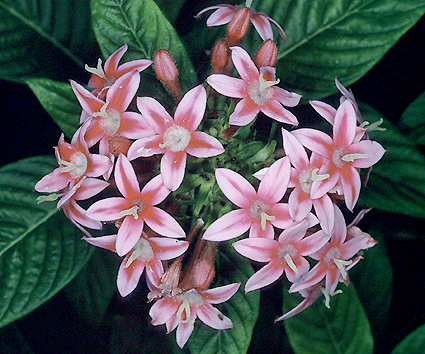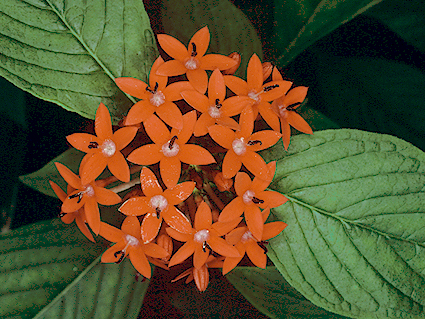Rubiaceae of the New World
By Piero Delprete and
Rocio Cortés
PENTAS Bentham
Rubiaceae of the New World
By Piero Delprete and
Rocio Cortés
PENTAS Bentham

Pentas lanceolata (cultivated) Photo S. Mori Marie Selby Botanical Garden, Sarasota, Florida, USA |

Pentas lanceolata (cultivated) Photo S. Mori University of South Florida, Tampa, Florida, USA |
Synonyms: Vignaldia A. Richard, Vignaudia Schweinfurth (orth. var.)
Erect herbs or shrubs; raphides present; axillary thorns absent. Stipules interpetiolar, basal sheath connate to the petioles, fimbriate, forming a collar around the stem, with 2–12 setae, each seta with an with apical colleter, persistent. Leaves opposite or whorled, 3 to 5 per node, long- to short-petiolate or subsessil; blades narrowly ovate, elliptic or lanceolate, chartaceous or papyraceous; foliar pellucid glands absent; domatia absent. Inflorescence terminal, frondose, cymose, multiflorous. Flowers bisexual, protandrous. Calyx tube extremely reduced, with small lobes, persistent; lobes 5, narrowly triangular, small. Calycophylls absent. Corolla hypocrateriform or narrowly infundibuliform, actinomorphic, white to cream-white, pink, red or violet to purple; tube externally glabrous or pubescent, internally pubescent; without a pubescent ring inside; orifice annular thickening absent; lobes 5, valvate, ovate, lanceolate or oblong, margin entire, acute at apex. Stamens alternate to the corolla lobes, included or partially exserted (only tips exserted); anthers elongate, round at base, round at apex, dehiscing by longitudinal slits, dorsifixed near the base; filaments attached at the middle of the corolla tube, free at base, slender, short (anthers subsessil), equal, glabrous. Style exserted well beyond the corolla, terete throughout, not fleshy, glabrous; lobes 2, linear. Ovary inferior, 2- or 3-locular, obovoid; placentation axile, placenta peltate to the entire lenght of the septum; ovules many per locule. Fruit a septicidal capsule, dehiscing basipetally, the valves secondarily splitting at apex, chartaceous. Seeds horizontal, minute, 3-5-angular; wings absent.
Geographic distribution: A genus of about 35 species native of Africa and Madagascar. Pentas lanceolata is often cultivated throughout the tropical and extra-tropical America as herbaceous ornamental.
Number of species: 1 (cultivated).